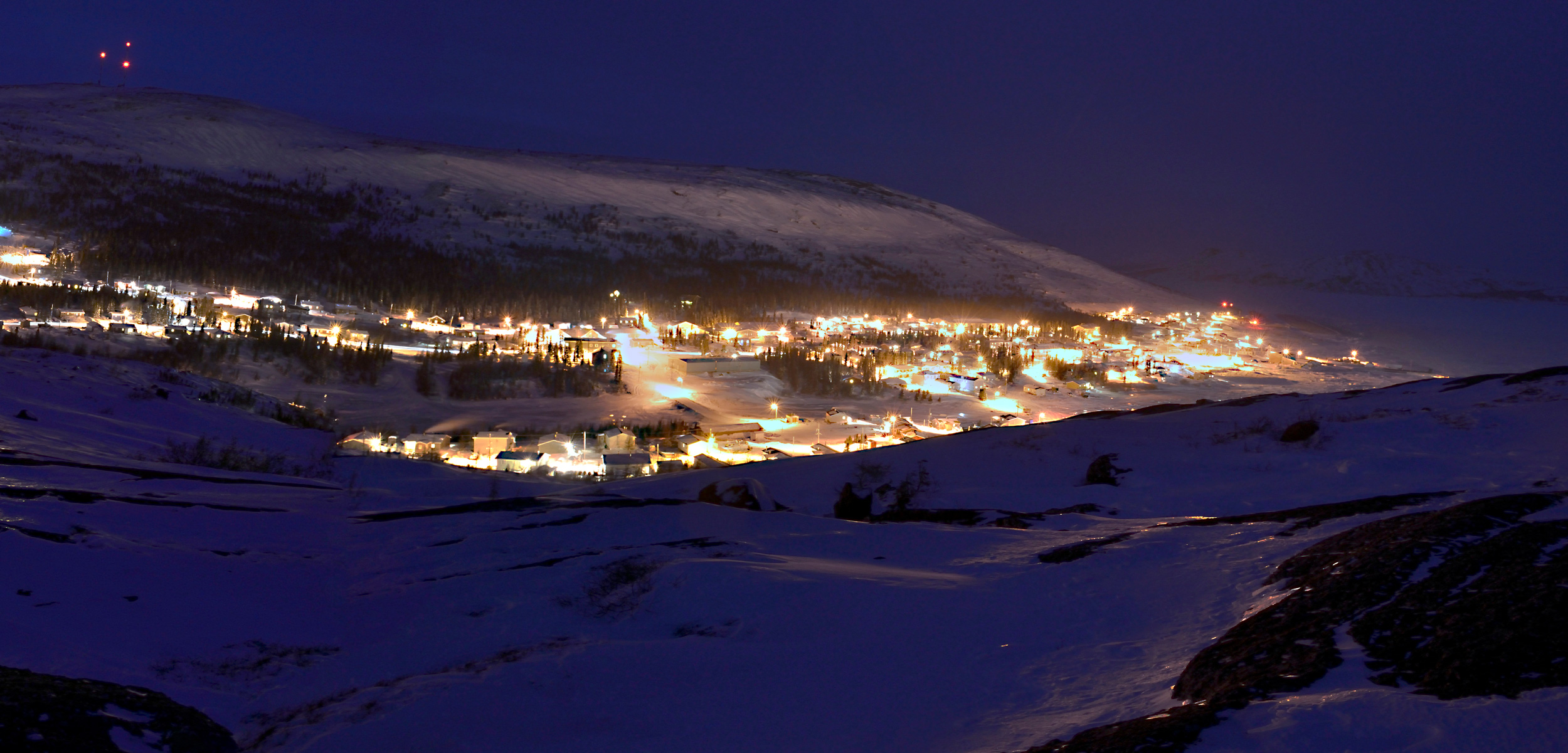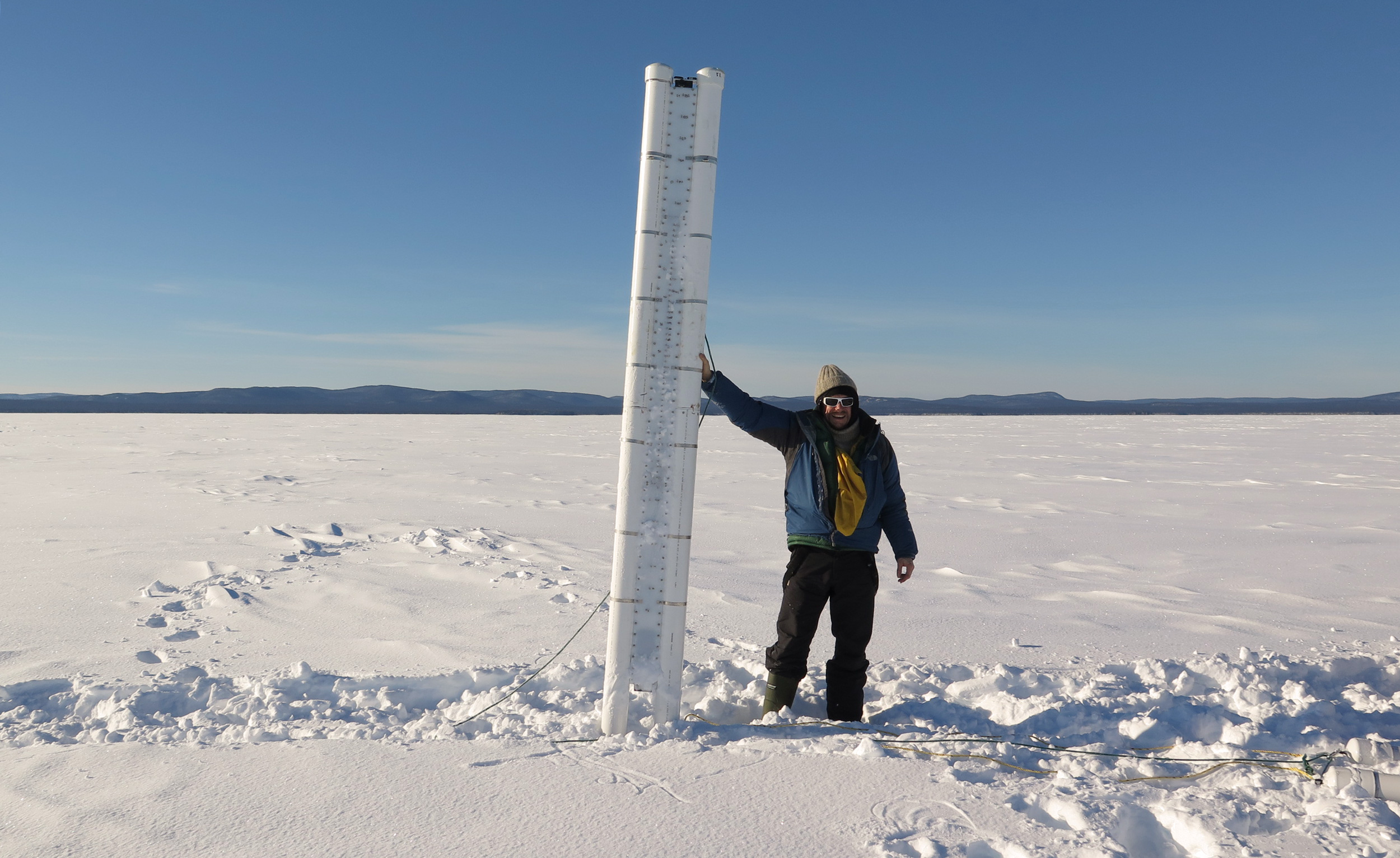People of the Sea Ice See Cracks Forming
One of Canada’s more northerly communities reinvents its relationship with a thawing landscape.
Article body copy
Jim Andersen was returning home on his snowmobile from a day of ice fishing in May 2014 when he saw the ice coating the river’s mouth break beneath a snowmobile ahead of him. Two villagers were aboard the sinking vehicle, which came to rest more than two meters deep in the frigid water. Andersen circled his snowmobile onto the shore to help. A man, almost fully submerged, was standing on top of the sunken snowmobile, struggling to keep himself and his companion above water and alive. “He was holding the lady up against the ice so she wouldn’t go under,” Andersen says.
Andersen threw the woman a rope, “but she was too weak to haul herself up,” he recalls. So from his snowmobile he unhooked a qamutik (sled) and pushed it onto the ice toward the rupture and climbed on. He pulled the pair, minutes from hypothermia, onto the qamutik, and then onto land and built a fire. The pair huddled close to the flames, warming up as they changed into dry clothes provided by their rescuer. Andersen told me this story last winter as we sat in his kitchen, the soft crackling in the woodstove punctuating the tale. He showed me the plaque that the town’s search and rescue group had awarded him. Late last year, the Canadian government awarded him the governor general’s Medal of Bravery.
In Arctic coastal towns like Nain, such unnerving scenes are common as the ice surrounding the villages steadily vanishes. The giant but shrinking expanse of sea ice that forms in the middle of the Arctic Ocean gets the bulk of global attention. But here along the coast, the sea ice that fastens to the land’s edge is the fabric of the Inuit world—and its melting affects lives. During the particularly warm winter of 2009 to 2010 in Nain, for example, one in 12 residents surveyed said they had fallen under the ice while traveling outside the community via snowmobile, what villagers call “going off.”
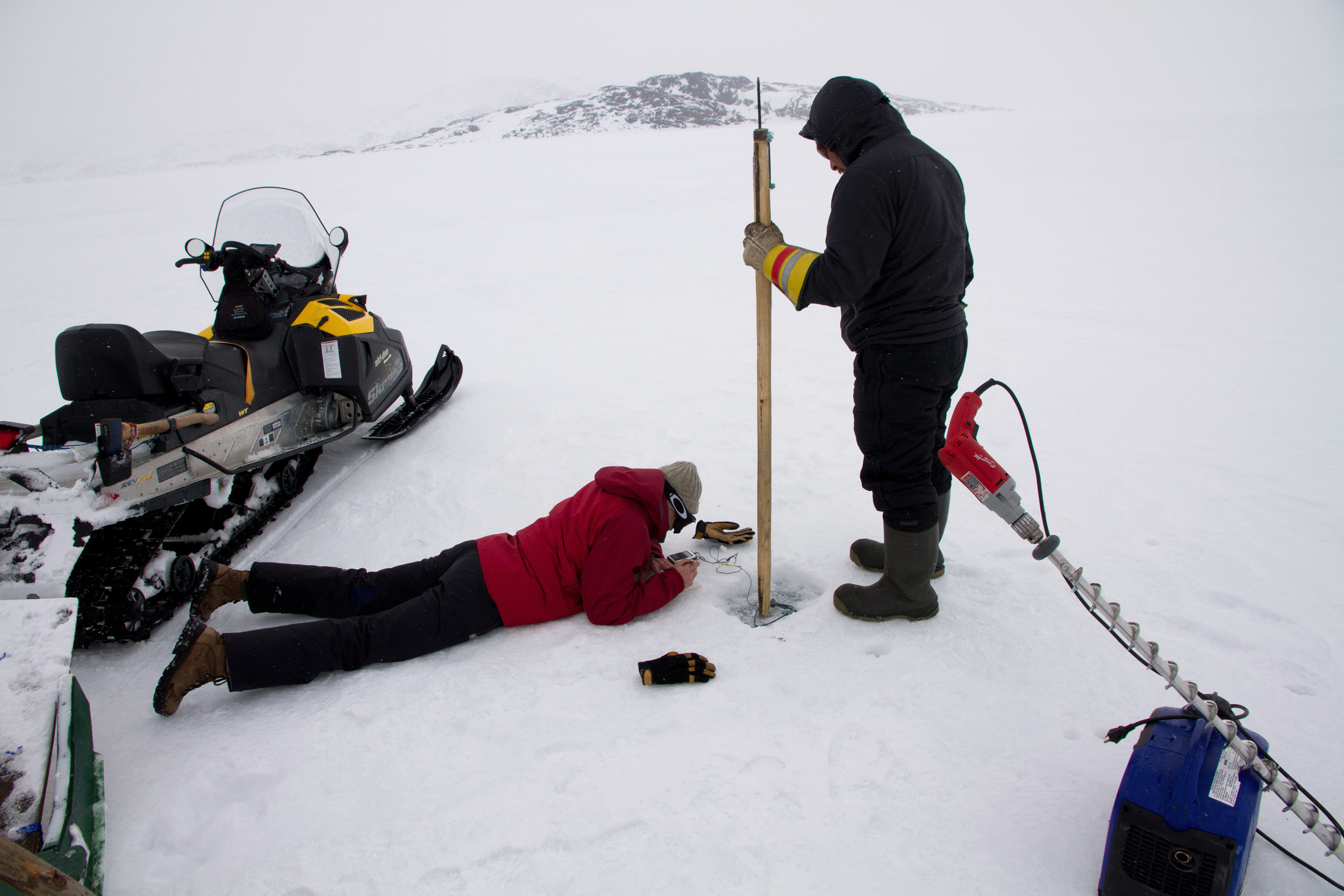
Engineer Rob Briggs and SmartICE community operator Joey Angnatok record sound through the sea ice for a new prototype sensor that measures ice thickness based on acoustic energy. Photo courtesy of SmartICE
The seasonal hunting schedule enhances the risk. Nain’s residents are most likely to fish or hunt seals in spring and fall when enough snow covers the ice for easy transport, yet temperatures are still relatively moderate. But in 2009, half of the surveyed villagers had to use alternative travel routes for fishing, hunting, collecting firewood, or trading goods. For a culture struggling to maintain its connection to traditional practices, thinning ice is an additional force keeping its people from the land. “We’re known as the Sikumiut, which means people of the sea ice,” says Ron Webb, a Nain hunter and entrepreneur. “Maybe not anymore.”
On a clear Monday morning in February, through the window of a Twin Otter propeller plane, Nain materializes on the horizon. The tiny community is the largest in Newfoundland and Labrador’s self-governing Nunatsiavut territory. The village sits on the Atlantic Ocean, amid a marbled collage of snow-covered icy rivers, lakes, and pine trees. I’m driven two minutes by snowmobile to the door of the town’s one motel. Like other northern towns, the village purposely accumulates snow on its streets for use by its 1,400 residents, who get around primarily by snowmobile. These frozen arteries flow smoothly in and out of the settlement, weaving the town into the surrounding icy wilderness.
Nain is among the places where water, the basis of life, is as familiar solid and frozen as it is fluid and aqueous. Subsisting at the margins between land and sea, and between ice and ocean, hunters and fishermen have always risked their lives on thin ice in Nain. For example, hunting on the coastal ice for migratory harp seals, prized for their pelts and meat, once meant late-autumn danger even for skillful hunters. “A lot of the older people used to go out sealing on the new ice, when it was still dangerous,” says Andersen. To mitigate those risks, hunters would drive their harpoons into the ice to test its thickness and if they fell in, use the tool to try to haul themselves out. Many didn’t make it; the hazards of ice travel are an integral part of Inuit culture.
Today, the risks are compounded. The overall geographic extent of the sea ice is plummeting: summer sea ice near Nain has declined by as much as 18 percent per decade. The period between breakup of the ice in the spring and ice-up in the fall is lengthening at a rate of one week per decade. The local impact is stark: ice-up used to be a sure thing by Christmas, but now residents can wait weeks into January before their watery environs are solid enough for snowmobiles. The spring and fall seasons, when conditions waver dangerously between frozen and ice-free are longer, too.
The people feel the ice regime changing under their snowmobiles. Meltwater pools on top of the ice are known as “rattles,” and they are particularly dangerous when they mask new, thin ice below. “The rattles are a lot bigger than they used to be,” Nain hunter Jacko Merkuratsuk told me. Double ice is another risk that’s common nowadays and one particularly difficult for hunters to spot from a distance. It forms when a rattle, say half a meter deep, freezes on top, creating a layer of water below a delicate top layer of ice. To avoid the hazards, hunters look for clues to potential dangers. These include winds heading offshore, which can break up sea ice near the coast, potentially dooming a hunter to the icy depths.
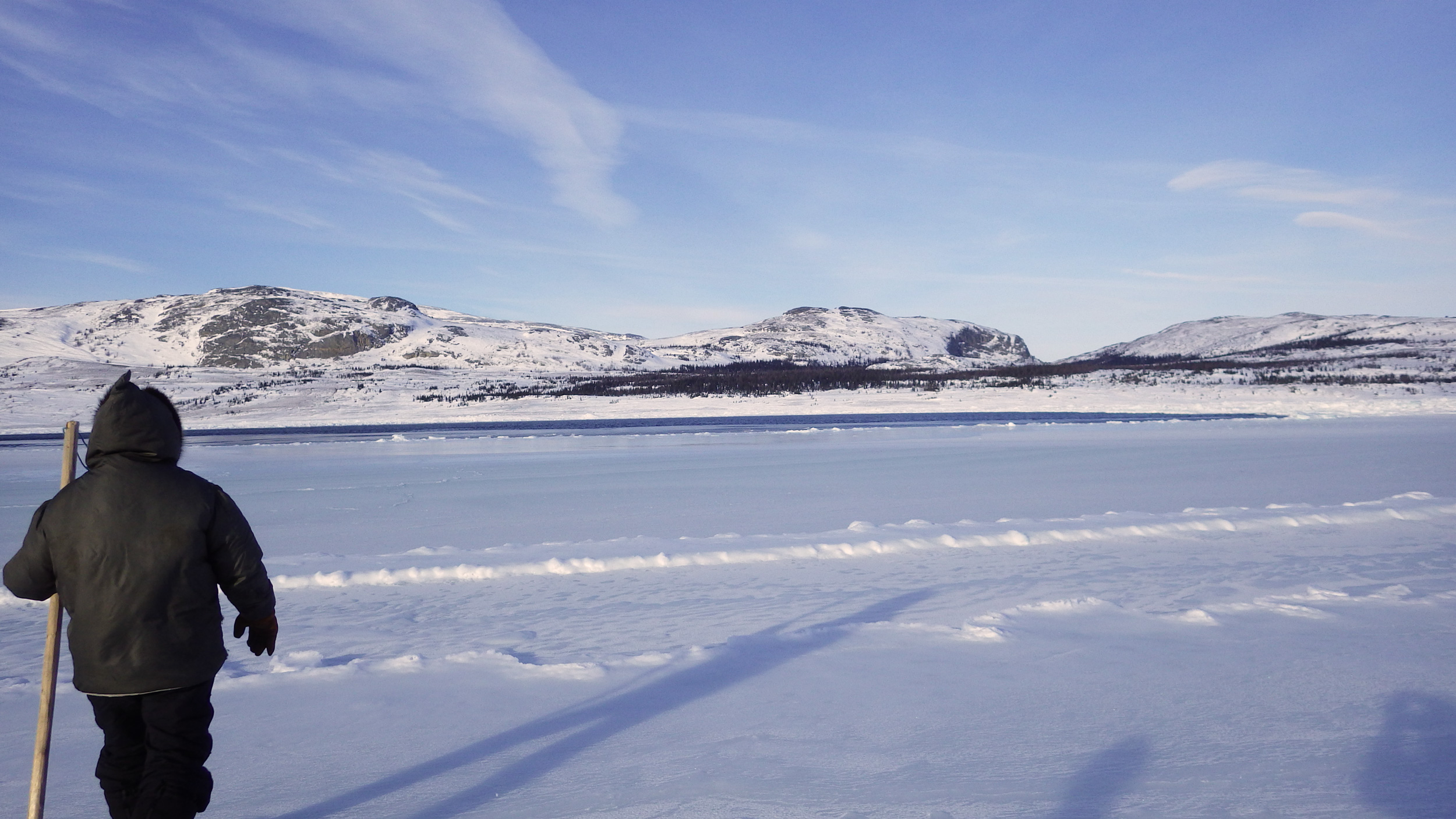
Nain fisherman Joey Angnatok tests the ice along a meltwater pool on top of the ice, as part of the SmartICE initiative, which is developing strategies to monitor ice. Photo courtesy of SmartICE
“People’s traditional knowledge of safe ice routes is no longer reliable,” says geographer Trevor Bell of Memorial University in St. John’s, Newfoundland. Bell is partnering with the Nunatsiavut government and the Canadian Ice Service to develop ice monitoring technology strategies. The project, called SmartICE (Sea-ice Monitoring And Real-Time Information for Coastal Environments), is run by Bell and engineer Rob Briggs of the engineering firm C-CORE. Their key collaborators include the Nain Research Centre and Nain fisherman Joey Angnatok, SmartICE’s community operator who collects data on the ground and provides general wisdom on the ice.
The Inuit are driving their snowmobiles on land more often, but that lengthens routes and leads to more breakdowns as the machines strike rocks and vegetation. During warm winters between 2009 and 2011, for example, “wear and tear on snowmobiles went up significantly,” says Tom Sheldon, former director of the Nain Research Centre.
The building that houses the center also includes a workshop, a community freezer for distributing meat to villagers, and office space. I walk upstairs, past the town’s only gift shop, to Sikumiut, Webb’s company, which developed tools to help protect the townspeople from thinning ice caused by industry.
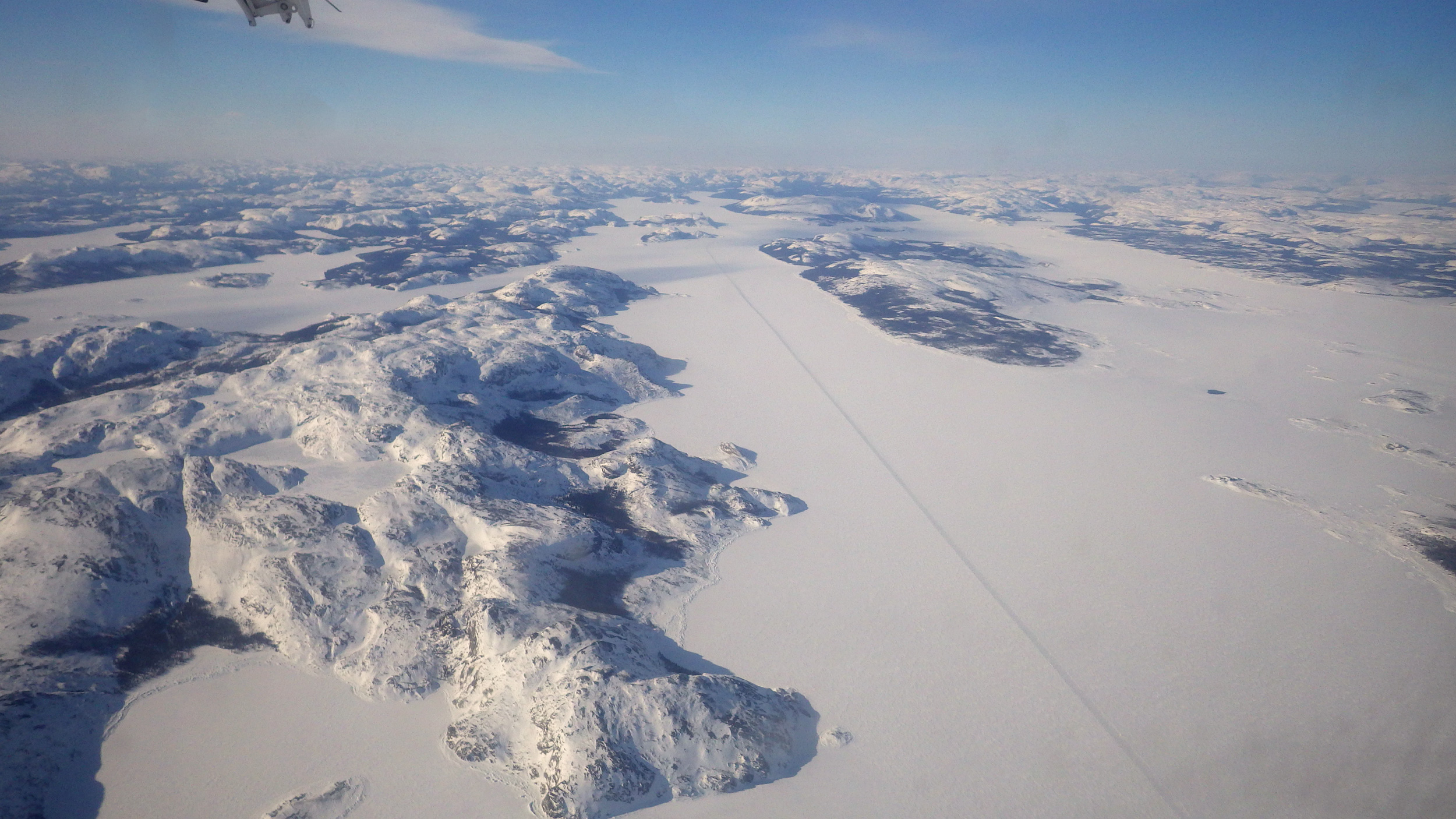
About eight times every winter, an icebreaker cuts tracks through the frozen sea and Inuit travel routes. While the ice refreezes, it can be thin and hazardous. Photo courtesy of SmartICE
To serve a nearby nickel mine, an icebreaker cuts a defined 30-meter-wide trough in the sea ice eight or so times each winter, bisecting Inuit travel routes. The ice refreezes after each pass, but to reduce the hazard of thin ice, Webb hires a local crew to install and maintain metal pontoon bridges that allow snowmobiles to cross the track in the ice created by the boat. Sometimes villagers in a rush—or those who just can’t be bothered—will skip the bridges and cross the refrozen chasm. “We haven’t had any accidents, but sometimes people will cross when it’s still dangerous,” says Webb. “It’s hard to get to sleep nights when you know the track is not safe.”
Two days later, I’m on the back of a snowmobile zooming east from town into a frigid, white landscape. Leading the caravan is Angnatok, whose snowmobile is pulling a qamutik with a sensor bolted on. The device records the ice thickness along our route, creating a color-coded map. We stop about 20 minutes into the journey to adjust the thickness sensor, drilling into the 60-centimeter-thick ice to ground truth the instrument. Through the hole, I can see mussels on the seafloor, about two meters below. “Welcome to the Atlantic Ocean,” says Angnatok. He jumps a few times on the ice, causing it to vibrate and my eyes to widen. Ever the wise guy, Angnatok smiles, pleased he’s unnerved me.
The crew includes Angnatok, Bell, Briggs, and some officials from the Nain Research Centre, including Liz Pijogge, a researcher and the driver of the snowmobile whose back seat I’m managing to occupy without getting flung off. Some of the staff at the research center tease me that I hold on to them unusually tightly when they give me a ride. What can I say? They take the town’s turns like daredevils! To avoid more ribbing, I grab on to the snowmobile handles until my knuckles, beneath several layers of gloves, are probably white from fear, not cold. (It’s -20 ˚C.) Occasionally, when the snowmobile engines are off, I can hear Enrique Iglesias emanating from Pijogge’s earbuds beneath her parka.
Aerial imagery belies the diversity of textures actually visible when you’re on the surface of this frozen world. We bounce over pillowy areas of snow, then glide along almost perfectly smooth patches, dusted by fresh flurries. Wind and sun have rendered other sections rough, giving our bottoms a beating. As round sun dogs form in the mid-afternoon sky, we arrive at an ice monitoring station. Here, the team installs sensors that monitor ice thickness below the surface and snow above, relaying the information to an online database by satellite. With ice diamonds clinging to his mustache, Angnatok brandishes a drill and cuts deep holes in the 30-centimeter-thick ice. Then the crew gingerly lowers the string of instruments, bolted to three-meter-long plastic pipes, into the ice. Almost immediately, the water begins to freeze around them.
The goal of the SmartICE project is to develop a regularly updated map of ice conditions for the hunters and fishermen of Nain. “You can imagine green, red, and yellow areas,” says Bell, who has been working on the SmartICE project since 2011. The hope is that overlaying weather data and satellite imagery could help make intelligent forecasts that would, for example, identify areas of high risk of double ice. This winter, the team intends to provide the data online in close to real time, augmented with data regularly collected by qamutik along common snowmobile routes.
When the sensors are properly ensconced in the ice, only about 30 centimeters of the sensor appears above the frozen landscape. Just as we set off for the next station, Briggs anxiously looks at the setup. He’s spent days building the apparatus, and imagines some wild scenarios where the sensor stops working. “I’m panicking. This is it! Now it breaks. Now some guy comes and attacks it with a shotgun.”
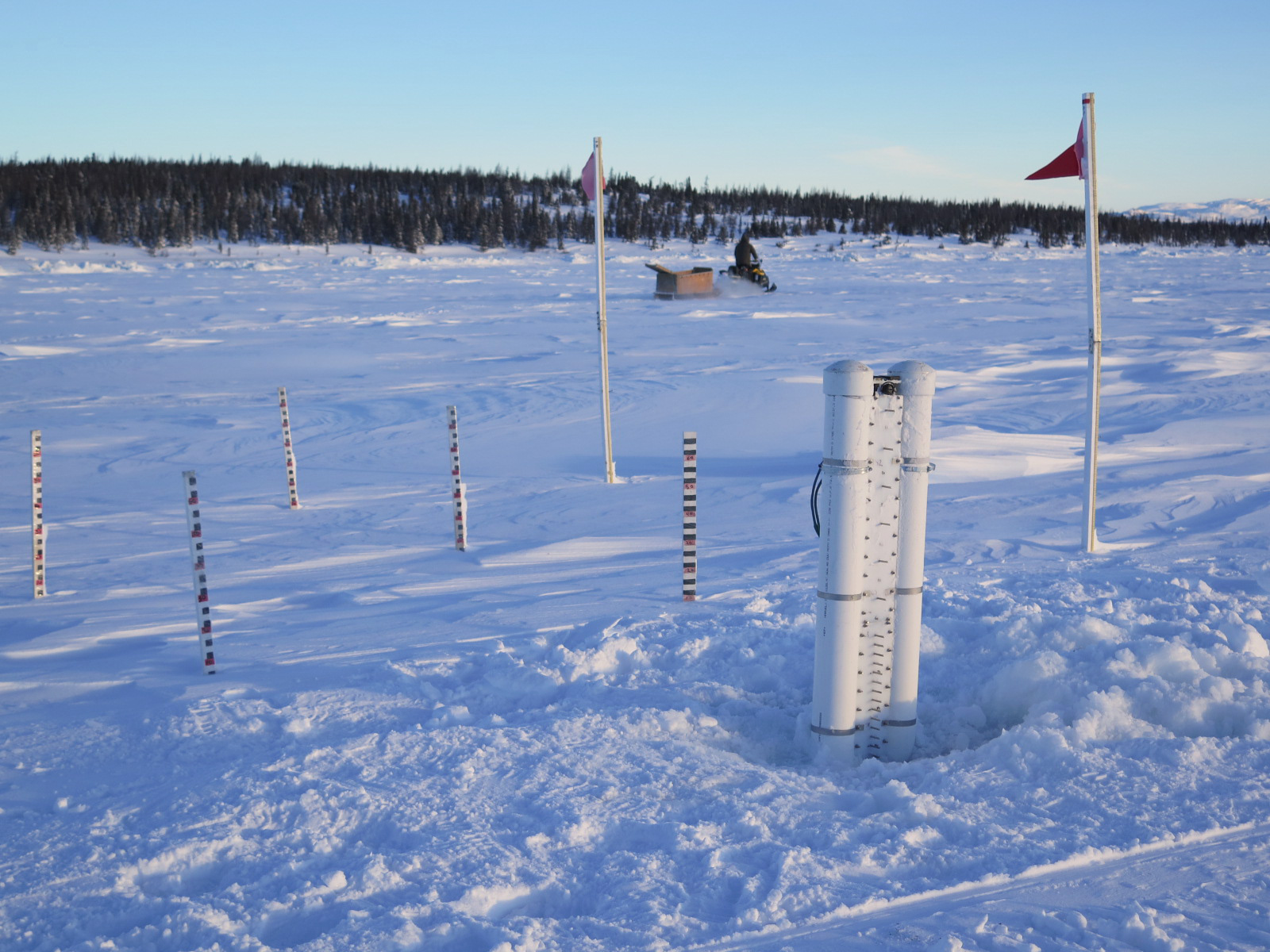
A sensor that looks like a giant thermometer is deployed to monitor the thickness of sea ice in Nain. Photo courtesy of SmartICE
Angnatok rolls his eyes. “So am I going to get a call tomorrow and say, ‘Joey, are you able to go out and …’”
“Reset it!” Briggs finishes Angnatok’s sentence, laughing.
We leave and soon after the data begins to stream to the satellite. “We’re adapting,” says Webb of his town’s efforts. “We have to.”
Nain’s residents are learning that part of adapting is adapting to loss and the interruption of their culture. Among the residents I met in Nain, those who rely most heavily on the land most acutely feel that loss. Recent years have dealt plenty of heartbreak to Nain’s Maria Merkuratsuk, born here on an unseasonably warm winter’s day in 1958. “My father says you have to wait many years for a rainy day in January,” she says. Her parents were born in wilderness areas far north of Nain, along the Labrador coast, before being relocated to Nain by the federal government.
She struggles with depression and alcoholism, though she “hasn’t touched a drink in 22 years,” she says. Her sister-in-law committed suicide in 2011, and two of her siblings have died since then. Authorities took away her son’s snowmobile driving privileges after he was cited for driving under the influence of alcohol. The feelings of isolation in Nain can be overwhelming, Merkuratsuk says. “I don’t know how to live a life. I don’t know how to make mistakes anymore,” she says, adding that her elders faced more financial difficulty but were “a lot happier.” Her life, she says “seems harder, more of a struggle than our ancestors experienced.”
Sitting at her kitchen table, she describes the one place where she feels a sense of peace—among the icebergs, pine trees, and mountains of Tassiujak Bay, 78 kilometers north of Nain. Merkuratsuk spent much of her childhood in her family’s cabins and tents there, hunting seals, fish, and polar bears. “I wish I could wake up every day to this view,” she says, gesturing at an exquisite photograph of her original home on her iPad. In Nain, she says, “I’ll get depressed, have no energy.” Then to Tassiujak she’ll head with her family on snowmobile and the world becomes bright again.
The steadily worsening ice situation has made it harder each year for Merkuratsuk’s family members to reach their homelands. To arrive by boat requires expensive fuel, limiting summer trips. But the late ice-ups have meant sometimes waiting until late January for winter visits by snowmobile. “We always used to be there by New Year’s,” she says. In the fall and spring, the thin sea ice impedes progress. But anomalous melts can even stymie travel in the dead of winter. One family trip to the cabins in February, for example, was halted when two of the three snowmobiles got stuck in double-ice slush, requiring hours of struggle to pull them out.
Merkuratsuk tells me that her family considers themselves “northerners,” different than their fellow villagers. The difficulty in getting to her true home in Tassiujak Bay compounds that feeling. “Ice is my freedom. It gets me firewood. It gets me to cabins. Without ice, I wouldn’t be able to breathe properly. It’s part of life,” she says. The ice is a psychological as well as physical part of Merkuratsuk’s world and each year it grows more and more fragile.
Reporting for this piece was supported by the Society of Environmental Journalists.

